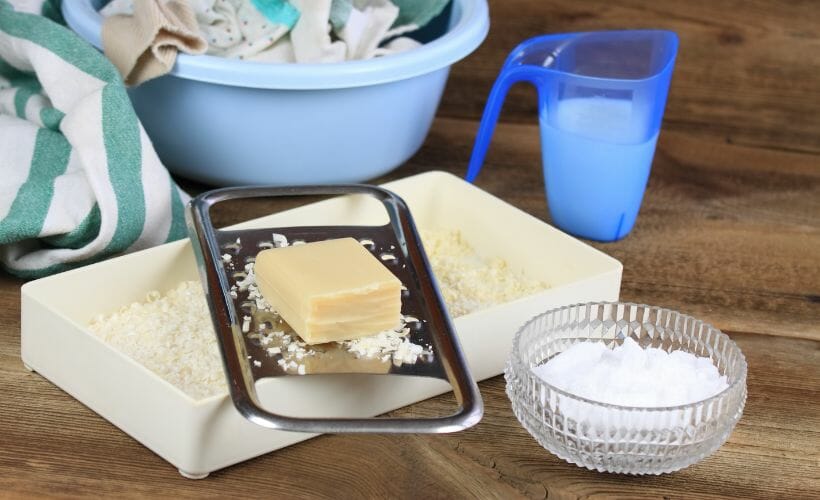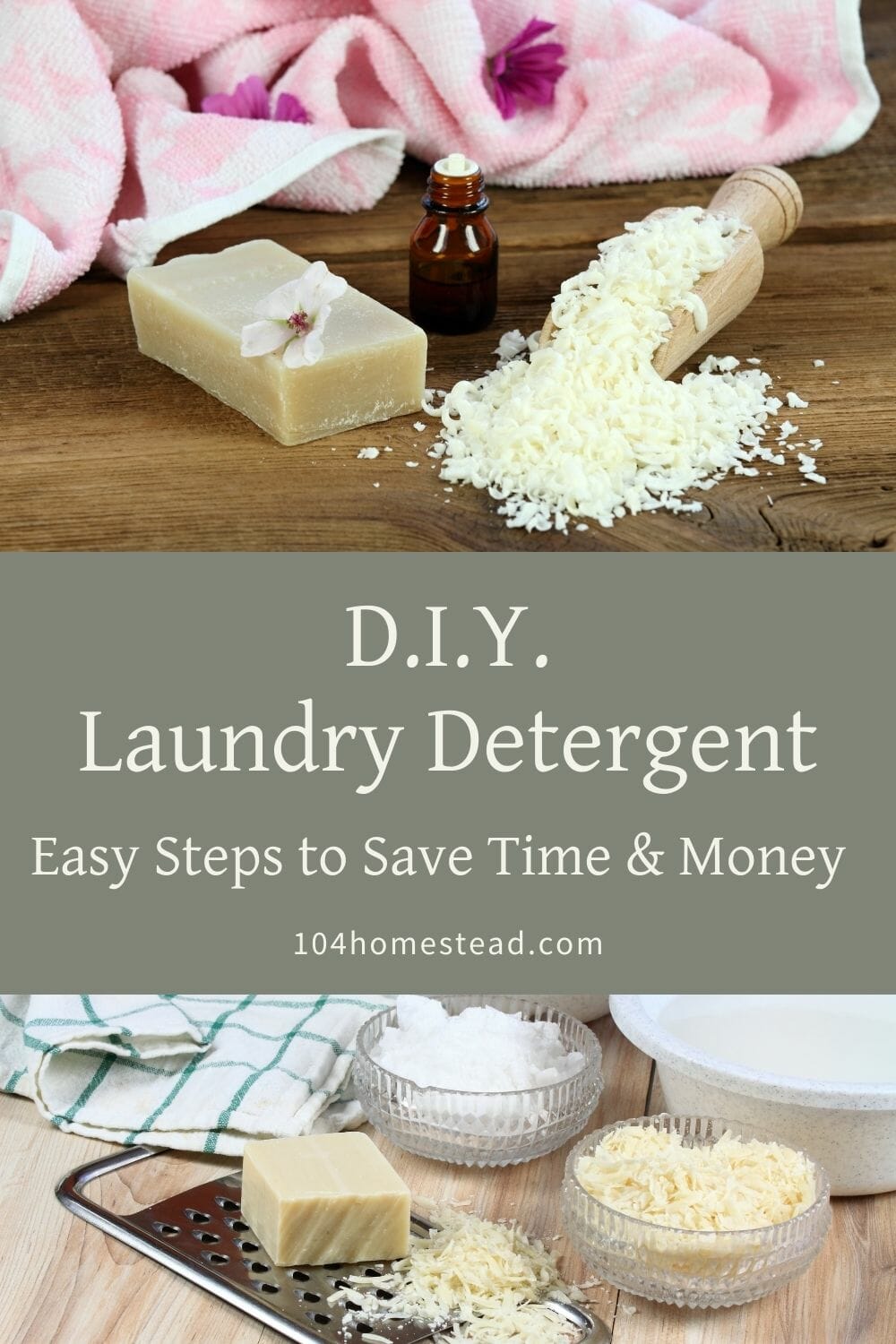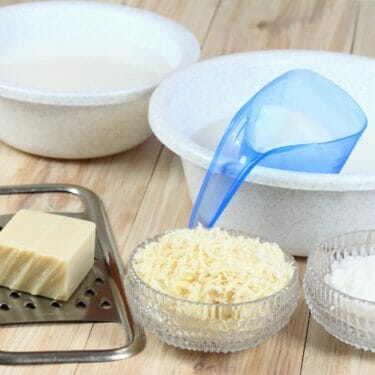How to Make Your Own Laundry Detergent & DIY Your Laundry
Learn how to make your own laundry detergent that is all-natural, cost-effective, and eco-friendly. Join the DIY revolution today!

Imagine a world where your laundry detergent not only cleans your clothes but also saves you money and protects the environment. It may sound too good to be true, but with a little DIY magic, you can revolutionize your laundry routine and make your own laundry detergent. No more wasting time and money on store-bought options that never quite meet your expectations.
Get ready to embark on a journey of discovery as we delve into the why, the how, and the benefits of homemade laundry detergent. By the end, you’ll be empowered to take control of your laundry routine and join the DIY revolution.
So, grab your apron, and let’s get started on this game-changing solution!
Why Make Your Own Laundry Detergent?
Making your own laundry detergent may seem like an unconventional choice, but once you understand the benefits, you’ll be eager to give it a try. By taking a step towards crafting your own detergent, you’re not only gaining control over the ingredients you expose your clothes and skin to, but you’re also contributing to a more sustainable future. Get ready to discover how you can save money, reduce waste, and prioritize the health of your family and the environment, all while achieving impeccably clean clothes.
Before you know it, you’ll be making all the cleaning products you need for your home from scratch.
The Benefits of Homemade Laundry Detergent
Make your own laundry detergent and you’ll not only gain control over the ingredients you expose your clothes and skin to, but you’ll also contribute to a more sustainable future.
Save Money
One of the most enticing benefits of homemade laundry detergent is the potential to save a significant amount of money. Commercial detergent products can be costly, especially if you have a large family or frequently do laundry. By making your own detergent at home, you can significantly reduce your laundry expenses without sacrificing cleanliness. The ingredients required for homemade detergent are often inexpensive and can last for multiple batches. This allows you to save money in the long run.
Minimize Environmental Impact
In addition to saving money, making your own laundry detergent also helps to minimize waste and environmental impact. Many store-bought detergents come in plastic containers that end up in landfills, contributing to pollution and harm to wildlife. By opting for homemade detergent, you can reduce your reliance on single-use plastic and create a more sustainable laundry routine. This homemade detergent recipe utilizes natural ingredients that are biodegradable and less harmful to the environment once they wash away.
No Harsh Chemicals & Fragrances
Another significant advantage of homemade laundry detergent is the ability to prioritize the health of your family and the environment. Commercial detergents often contain harsh chemicals and artificial fragrances that can irritate sensitive skin and trigger allergies. By making your own detergent, you are excluding any potential irritants or harmful substances. This is particularly important if you or your family members have skin sensitivities or respiratory issues. Homemade detergent gives you peace of mind, knowing that you are using a gentle and safe product on your clothes and linens.
We used soap nuts for a long time for our laundry, but they can get a bit pricey and it turned out my youngest was allergic to them. That’s when I started making detergent myself.
Now that you understand the benefits of homemade laundry detergent, it’s time to delve into the easy steps to make it. With just a few simple ingredients and a little bit of time, you’ll be well on your way to revolutionizing your laundry routine.
Easy Steps to Make Your Own Laundry Detergent
First, gather the necessary ingredients. You’ll need washing soda (you can buy it or make your own washing soda in minutes), baking soda, grated bar soap, and optional essential oils for fragrance. These ingredients are readily available at most supermarkets and are often found in the laundry aisle or the cleaning supplies section. It’s important to note that bar soap should be free of any harsh chemicals or artificial fragrances, as this defeats the purpose of making your own detergent for health and environmental reasons. Fels Naptha is a laundry soap bar you can use, but it contains titanium dioxide, which may bother some people who want a completely natural product.
The Homemade Laundry Detergent Recipe
Once you have your ingredients, it’s time to begin the process. Start by grating the bar of soap into fine shreds. You can use a cheese grater or a food processor for this step. Make sure the soap is finely grated to ensure it dissolves easily in the wash. It’s best to have a cheese grater or food processor just for grating soap because it may cause a soapy flavor to your food.
Next, combine one part washing soda, one part baking soda, and two parts grated bar soap in a large bowl. Stir the mixture thoroughly to ensure the ingredients are well combined. If desired, add a few drops of your favorite essential oil to give your detergent a pleasant scent. Lavender, sweet orange, or eucalyptus are popular choices, but feel free to get creative and experiment with different combinations.
After you’ve thoroughly mixed the ingredients, transfer the detergent into an airtight container for storage. A mason jar or a recycled detergent bottle works well for this purpose. When my kids were little and there was a lot more laundry, I used a 5-gallon bucket to make it in bulk. Label the container to avoid confusion and keep it out of reach of children.
How to Use Your Homemade Laundry Detergent
To use your homemade laundry detergent, simply add one to two tablespoons, depending on the size of your load, directly into the washer drum or the designated detergent dispenser. This detergent works well in both standard and high-efficiency washing machines.
Tips & Variations for Customizing Your DIY Laundry Detergent
Let’s dive into some helpful tips and variations that will allow you to personalize your detergent even further, catering to your unique laundry needs.
1. Scent Sensations
One of the joys of making your own laundry detergent is being able to choose the scent that will accompany your clean clothes. You can add a few drops of your favorite essential oil to the detergent mixture, giving your laundry a delightful fragrance.
I like to make scent blends and change them out seasonally. I use the same scent blends in my household cleaning products as well.
2. Stain-Busting Boosters
For tough stains, you can enhance the cleaning power of your detergent by including some stain-busting ingredients. Consider adding a teaspoon of baking soda or white vinegar to the detergent mixture. Borax is a natural stain remover that breaks down acidic and protein-based stains. It’s handy if you have small children.
3. Softness and Freshness
If you love the feeling of soft and fresh laundry, there are a couple of ways to achieve that with your homemade detergent. First, you can add a quarter cup of baking soda to the wash cycle. Baking soda helps brighten and soften your clothes and acts as a fabric softener and deodorizer. If you want an extra burst of freshness, a few drops of lemon juice to the rinse cycle can work wonders.
4. Allergen-Free Options
If you or someone in your household has sensitive skin or allergies, you can easily customize your detergent to be hypoallergenic. Simply opt for unscented castile soap as the base ingredient and avoid adding any additional fragrances. This way, you can know that your laundry detergent will be gentle on your skin.
5. Experiment with Measurements
Every laundry load is different. You may find that the recommended one to two tablespoons of detergent is not suitable for every situation. Don’t be afraid to experiment with the measurements to find the perfect amount for your needs. Start with a smaller amount and gradually increase or decrease it based on the size and dirtiness of your load.
By implementing these tips and variations, you can truly revolutionize your laundry routine. Creating your own laundry detergent is not only a cost-effective and eco-friendly choice but also an opportunity to tailor your detergent to your preferences and laundry requirements.
Make Your Own Dryer Sheets & Wool Dryer Balls
Are you tired of paying too much for disposable dryer sheets? You’re not alone. The average American spends almost $200 per year on dryer sheets alone. Most of these products contain harsh chemicals like benzyl acetate and phthalates that can harm both the environment and our health. Luckily, there’s a simple solution to break free from this costly, toxic cycle: make your own dryer sheets and wool dryer balls.
Homemade dryer sheets and wool dryer balls can help reduce the cost of doing laundry and provide natural alternatives that pair beautifully with homemade laundry detergent. Or you can ditch the dryer altogether and instead line-dry your clothes (yes, even in the winter).
If you’ve found value in this blog post and enjoyed reading it, why not share it with your Pinterest community? Pin the image below and spread the love!

Creating your own laundry detergent is a game-changing solution that not only saves you money and eliminates harmful chemicals, but also gives you complete control over the ingredients you use. By revolutionizing your laundry routine through DIY, you’re leaping into a world of all-natural cleanliness and sustainability. Take charge of what goes into your clothes, save the planet, and transform your laundry experience today.
Join the DIY revolution and embrace a better laundry routine for you and the environment.
What’s your go-to DIY laundry detergent recipe or tip? Share your laundry wisdom in the comments below!

Homemade Eco-Friendly Laundry Detergent
This post may contain paid links. If you make a purchase using the links in this recipe, I may earn a commission.
Equipment
- Cheese Grater or Food Processor
Ingredients
- 1 bar Fels Naptha or other chemical-free bar soap
- 1 c. Washing Soda
- 1 c. Baking Soda
- Essential Oils optional
Instructions
- Start by grating the bar of soap into fine shreds. Make sure the soap is finely grated to ensure it dissolves easily in the wash.1 bar Fels Naptha
- Combine washing soda, baking soda, and grated bar soap in a large bowl. Stir the mixture thoroughly to ensure the ingredients are well combined.1 c. Washing Soda, 1 c. Baking Soda
- Add a few drops of your favorite essential oil to give your detergent a pleasant scent.Essential Oils
- Transfer the detergent into an airtight container for storage.

Borax vs baking soda. Are they the same?. So can I use borax instead of the baking soda?
Do you think I could use my own homemade goat milk soap instead of the Fels Naptha?
I haven’t tried it, but I’m sure it would work just fine. The only ones I would stay away from are harsh store-bought soaps. Those contain all sorts of gunk. Homemade thankfully doesn’t have that. Be sure to report back how it went if you try it.
I love Fels-Naptha soap! It lifts stains and gets my clothes a lot cleaner. I use a vegetable peeler to shave the soap. It dissolves fine in our cold well water.
Thanks for posting the vegetable peeler tip to shave the soap!
You’re so welcome. Figuring out that little trick was my saving grace.
I started using homemade laundry detergent 2 years ago. I did some experimenting and ended up making powdered detergent that I liked better. I use this same recipe. I’ve had my detergent get old stains out of my husband’s shirts. It’s even gotten the stains from a fire out of a shirt belonging to a friend who is a firefighter. My sister in law loves it so much that she started calling it laundry crack. I have found that in making the powdered version that the Fels-naptha will mix in with the other ingredients better if you put it through a food processor. I used the grating attachment to grate it then put my regular blade attachment in, added the grated Fels-Naptha, Borax and Washing Soda and mixed it all together in the food processor with the blade. I have hard water and have no problem with my Fels-Naptha dissolving.
Hi-I just found your blog and I really like it! I have been making my own laundry detergent for quite a while and have tried several recipes and tricks to make it work for me. First of all, we have hard water here and that contributes to graying on whites and light colors. The fix is a half cup of white vinegar in the fabric softener cup. This also deodorizes ands any lingering vinegar scent disappears as the clothes dry. Also helps to line dry in the sunshine whenever possible. One reader noted that the fells naphtha soap doesn’t dissolve in the wash. This very old product was formulated to use in bar form to rub over stains back in the washboard days, so it is made to last, i.e., dissolve very slowly. I find it helpful to let the bars dry out unwrapped for a good long time–months. This makes it a bit crumbly and it will produce smaller bits when grated. It can also be dried for several days after grating then tossed into a blender or food processor to make more of a powder. Be aware that mice seem like to eat this soap, good idea to keep it in a glass jar or metal container. I also grate saved up slivers of bath soap, but bars that are “superfatted” or state they have emollients, moisturizers or butters don’t go into the laundry soap. If I have greasy or oily spots to deal with I pre-treat directly on the stain with dish soap. I think the small quantity used would not produce enough suds to cause problems with an HE washer, but I don’t know. You could always rinse it before putting it in or use the fels-naphtha bar to pre-treat on wet fabric. I have recently learned about a laundry bar called “Zote” that is made in Mexico and has been the go-to there for decades. I have not tried it butplanto pick some upfor my next batch of laundry detergent The #1 advantage is that it does not contain any petroleum distillates like fels-naphtha does. It is available at that big “W” store for less than $1 for a 14 oz. bar. It also comes in a box already grated, 17 oz. under $3. Still a good bargain, especially if you tend to grate your knuckles as I do from time to time!
I use this recipe but I use ivory soap instead. It is 99% natural and smells better. I’ve been using it for years and it works great. I have babies and it cleans their clothes perfectly.
I’ve never had good luck with this. I ended up going back to another detergent. When I used it as a powder in my front load machine the fels naptha didn’t dissolve. It did not get farm clothes clean and my whites looked awful. I ended up spending way more money on replacing stained and dingy clothes that I saved. I had my water checked and it is well within normal in all areas. I really wanted this to work but it didn’t at all.
I’m sorry it didn’t work for you. We’ve had good luck with it, but everyone’s laundry is different.
Hi,
I would like to know what is Fets- Naptha soap. Please kindly let me by email
If possible any kind of soap I can grate and put inside the mixture or not? thanks and hope to hear from you.
almas nathoo
Fels naptha is a laundry soap that contains sodium hydroxide (the lye used to make soap), tallow, coconut oil and/or palm oil. I have heard good things from people about switching it out for homemade soaps like goat milk soap.